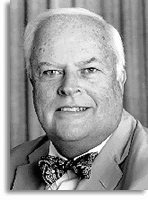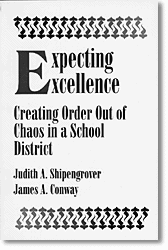
New book details transformation of Ken-Ton School District
Researchers show how community efforts moved district from mediocre
to excellent
By PATRICIA DONOVAN
News Services Editor
 A new book by education researchers at UB offers a
detailed account of
how one community turned its middle-of-the-road school district into one
of the most exemplary in the United States.
A new book by education researchers at UB offers a
detailed account of
how one community turned its middle-of-the-road school district into one
of the most exemplary in the United States.
"Expecting Excellence: Creating Order Out of Chaos" (Corwin Press)
traces the 13-year progress, from 1981 to 1994, of the Kenmore-Town of
Tonawanda Union Free School District as it successfully applied
industrial principles of shared decision-making to the development of a
school-based system of management.
Authors James A. Conway, UB associate professor of education,
and
Judith A. Shipengrover, senior education specialist in the UB School of
Medicine and Biomedical Sciences, offer hands-on guidance to other
communities that want to improve their schools.
In the 1970s, the district in suburban Buffalo went through a period
of greatly declining enrollments, teacher layoffs, school closings and
low teacher and parent morale. From the early 1980s to the mid-1990s, it
transformed itself from a respected but complacent, bureaucratic, closed
organization with less than challenging expectations of its students
into what the authors call "a teaching and learning community for the
21st century."
The book offers a step-by-step examination of exactly how the district
developed shared planning teams, peer clinical supervision, new
monitoring processes, new incentives to improve professional training, a
teachers' training center, teachers' mentoring program and other
strategies.
 Today, decision-making is not just a series of
political
compromises; instruction is diverse enough to ensure that all students
are engaged in learning; teachers, parents, administrators, custodians
and bus drivers together engage in research as a process to solve
problems, and teachers and staff determine the content of their own
professional development.
Today, decision-making is not just a series of
political
compromises; instruction is diverse enough to ensure that all students
are engaged in learning; teachers, parents, administrators, custodians
and bus drivers together engage in research as a process to solve
problems, and teachers and staff determine the content of their own
professional development.
The district now is run largely by elected school planning councils
with significant involvement in decision-making by teachers, board
members, administrators, community members, neighbors, clerical staff,
parents, students and facilities staff.
Despite their early skepticism, teachers, parents, students and other
parties came together to build, from the inside out. In the Ken-Ton
School District, changes for the better were reflected in student
performance: higher elementary reading, math and writing scores; a
steady increase in mean SAT scores; an increase in the percentage of
students receiving college scholarships from 17 to 23 and the percentage
going to college from 75 to 80, and a decrease in the drop-out rate from
4.6 percent to less than 1.5 percent. Enrollment in continuing education
programs increased by 81 percent.
By 1988, 12 of the district's 13 schools had been cited as a "School
of Excellence" by the State of New York and seven were named "National
Schools of Excellence" by the U.S. Department of Education.
And community support grew. Since 1987, elections on school budgets and
bond issues have passed by a considerable majority-more than 80 percent.
Conway said that none of this was accomplished without difficulty.
The plan encountered much resistance from the outset. Once it was
announced, one-third of the principals took early retirement. The school
board was wary. The teachers' union offered support, but even with that,
it took four years to implement the first change.
"It took a long time," Conway said, "but as a result, the ability to
set goals, identify problems and solve them quickly is totally embedded
in the Ken-Ton system and has completely altered the way it operates."
Conway has, over the last 35 years, taught higher-education research
at colleges and universities that include UB, Buffalo State College, the
University of Miami and University College, Galway (Republic of
Ireland). His work has been published in many professional journals and
in several books.
Shipengrover is a curriculum consultant to the Robert Wood Johnson
Generalist Initiative Project at the UB School of Medicine and
Biomedical Sciences, where she facilitates curriculum reform linked to
the preparation of primary-care physicians. She received her doctorate
from the UB Graduate School of Education.
![[Current Issue]](http://www.buffalo.edu/reporter/icons/Goto_Current.gif)
![[
Table of Contents ]](http://www.buffalo.edu/reporter/icons/TOC.gif)
![[
Search Reporter ]]( http://www.buffalo.edu/reporter/icons/Newspaper.gif)
![[Talk to
Reporter]](
http://www.buffalo.edu/reporter/icons/Phone.gif)
 Today, decision-making is not just a series of
political
compromises; instruction is diverse enough to ensure that all students
are engaged in learning; teachers, parents, administrators, custodians
and bus drivers together engage in research as a process to solve
problems, and teachers and staff determine the content of their own
professional development.
Today, decision-making is not just a series of
political
compromises; instruction is diverse enough to ensure that all students
are engaged in learning; teachers, parents, administrators, custodians
and bus drivers together engage in research as a process to solve
problems, and teachers and staff determine the content of their own
professional development. 
 A new book by education researchers at UB offers a
detailed account of
how one community turned its middle-of-the-road school district into one
of the most exemplary in the United States.
A new book by education researchers at UB offers a
detailed account of
how one community turned its middle-of-the-road school district into one
of the most exemplary in the United States.